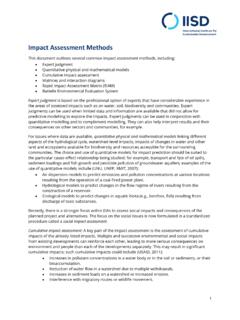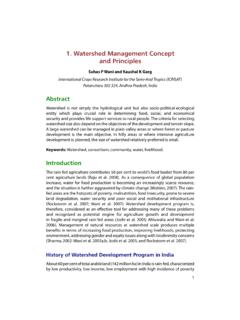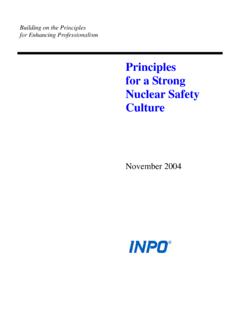Transcription of Module 107 – Hydrographs Study Guide - USDA
1 Module 107 Hydrographs Study Guide Engineering Hydrology Training Series Module 107 Hydrographs Module Description Objectives Upon completion of this Module , the participant will be able to: 1. Define hydrograph. 2. List the various types of Hydrographs . 3. Describe the various hydrograph components. 4. List the uses of Hydrographs in SCS. The Participant should be able to perform at ASK Level 2 after completing the Module . Prerequisites Module 101-Introduction to Hydrology. Length Participant should take as long as necessary to complete this Module .
2 Training time for this Module is approximately one hour. Who May Take the Module This Module is intended for all SCS personnel who need an introduction or overview of Hydrographs . Method of Completion This Module is self- Study , but the state or NTC should select a resource person to answer any questions that the participant's supervisor cannot handle. Content This Module lists the various types of Hydrographs , defines their components and lists the uses of Hydrographs in SCS. Contents Module Description .. v Introduction.
3 1 Types of 1 Physical Factors that Influence Shape .. 4 Hydrograph Components .. 5 Activity 1 .. 7 Activity 1 - Solution .. 9 Uses of 11 Activity 2 .. 13 Activity 2 - Solution .. 14 Summary .. 15 Introduction Types of Hydrographs A hydrograph is a graph showing stage, discharge, velocity, or other properties of water flow with respect to time. When the stage is plotted against time, the graph is a stage hydrograph (which is the form of a stream gage record).
4 When the discharge is shown against time, the graph is a discharge hydrograph. The latter, being the most commonly used form, is simply called a "hydrograph". This Module describes the various types of discharge Hydrographs (hereafter referred to as " Hydrographs "), the various graphic features of a hydrograph, and the most common uses of Hydrographs in SCS work. In its simplest form, a hydrograph is a graphical representation of runoff rate against time (Figure 1). It shows the time distribution of runoff at the point of measurement or computation, reflecting the complex characteristics of the watershed by a single curve.
5 One characteristic, the duration or time of flow, is nearly a constant for a particular watershed , regardless of the value of the peak flow from a specific storm, assuming constant storm duration. There are several types of Hydrographs which include: 1. Natural hydrograph 2. Unit hydrograph 3. Dimensionless unit hydrograph 4. Synthetic hydrograph 5. Dam breach hydrograph (Special case - natural or synthetic) Natural Hydrograph A natural hydrograph is one recorded at a stream gaging site and is a fingerprint of the upstream drainage area's response to rainfall (Figure 1).
6 Unit Hydrograph A unit hydrograph is a natural or synthetic hydrograph representing one inch of runoff', uniformly from the watershed during a specified time. In other words, the area under the graph is actually a volume of one inch of runoff. Dimensionless Unit Hydrograph A dimensionless unit hydrograph is a generic combination of many natural unit Hydrographs . The ordinate and abscissa scales are ratios of the discharge with respect to the peak discharge and the time relative to the time ,to peak, respectively (Figure 2).
7 Synthetic Hydrographs A synthetic hydrograph is calculated based on watershed and storm characteristics. (In SCS, soils, land use, vegetative cover, size, slope, and time of concentration are important watershed characteristics.) Synthetic Hydrographs are used to simulate natural Hydrographs for ungaged watersheds (Figure 3). The peak flow charts in Chapter 2, Engineering Field Manual and in Technical Release 55 were developed from the peaks of many synthetic Hydrographs . These charts are used in the design of conservation practices, such as grassed waterways, channels, terraces, ponds, etc.
8 Two additional uses made of synthetic Hydrographs are for reservoir routing and reach routing (Figure 3a). These are important Hydrographs in SCS. Dam Breach Hydrograph A dam breach hydrograph represents the sudden release of water from the impoundment due to a breach, followed by the draining of the reservoir. The volume represented by the hydrograph is the storage volume of the reservoir released during the breach. Factors affecting the shape of the breach hydrograph include: size and shape of breach, depth of water at the dam, volume of stored water, surface area of reservoir, and shape (especially length) of reservoir.
9 A breach hydrograph can be natural (recorded) or synthetic (a simulation). Figure 4 shows a breach hydrograph from the instantaneous failure of a dam. Physical Factors that Influence Shape The most common physical factors influencing the shape of a hydrograph are: 1. Topography (slope). 2. watershed shape (fan/elongated). 3. Size of watershed . 4. Stream channels and flood plains (size, depth, width, etc). 5. Rainfall (amount, duration, distribution). 6. Land use and vegetative cover. 7. Soil types. Hydrograph Components A hydrograph is made up of several parts which, taken together, reveal considerable information about the watershed .
10 Take, for example, the hydrograph shown in Figure 5. Graphical Features Graphical features of a hydrograph include the following points: A Point of rise B. Rising point of inflection C. Peak D. Recession point of inflection E. End point of recession These points, in turn, delineate the following segments (Figure 6): A-C Rising limb - Generally reflects storm characteristics. B-D Crest segment - Highest concentration of runoff. C-E Recession limb - Withdrawal of stored water. A-E Base time of hydrograph - Duration of runoff.


















